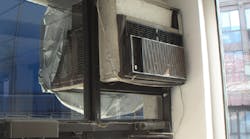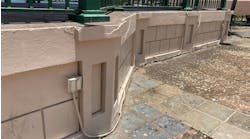How well do you know the Code? Think you can spot violations the original installer either ignored or couldn't identify? Here's your chance to moonlight as an electrical inspector and second-guess someone else's work from the safety of your living room or office. Joe Tedesco, who has a knack for finding shoddy electrical work, did the dirty work and found this mess. Now it's your turn to identify the violation.
Find the Answer
According to the requirements of 440.63, an attachment plug and receptacle is permitted to serve as the disconnecting means for a single-phase room air conditioner rated 250V or less if (1) the manual controls on the room air conditioner are readily accessible and located within 1.8 m (6 ft) of the floor or (2) an approved manually operable switch is installed in a readily accessible location within sight from the room air conditioner.
2002 NEC Section 110.26(B) requires clear working spaces about electrical equipment, and no storage is permitted, even trash storage is not allowed. When normally enclosed live parts are exposed for inspection or servicing, the working space, if in general open spaces, must be suitably guarded. See also, 230.70(A)(1) where a service disconnecting means is required to be installed at a "readily accessible" location either outside of a building or structure or inside nearest the point of entrance of the service conductors.
The requirements of 210.52(C)(1) make it clear that when working in the kitchen of a dwelling unit you shall install receptacle outlets at each wall counter space that is 12 in. wide, or wider. In addition, the receptacle outlets shall be installed so that no point along the wall line is more than 24 in. measured horizontally from a receptacle outlet in that space.



